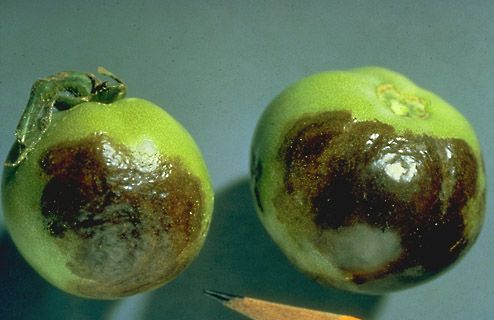
For greenhouse owners and gardeners in the Carolinas and Georgia, here is some disturbing news: Some tomato plants in Beaufort County, South Carolina, have recently been infected with late blight disease, the same highly infectious scourge that caused the Irish potato famine in the 1840s. Tomatoes and potatoes are related species, both belonging to the Solanaceae family. This is also the family to which eggplants, petunias, tobacco, and a wide variety of other flowering plants belong. However, most of these other species, with a few exceptions, are rarely if ever susceptible to late blight.
Late blight is caused by a fungus-like pathogen, Phytophthora infestans, which thrives when days are moderately warm, nights are cool (but frost-free), and conditions are cloudy and wet from rain, fog, or heavy dew. The first symptoms of late blight are brownish-gray lesions on leaves, stems, and fruit, which quickly spread and kill the host plant. In the process, a great many pathogen spores are produced, up to 300,000 a day on a single lesion. These spores are easily blown by wind to other plants up to five miles away. When a spore lands on a susceptible plant, it can germinate within hours and kill the plant in about a week.
Late blight spores can be destroyed with strong fungicides, like those that commercial growers use. But for home greenhouse gardeners, the cost of these commercial products (such as Ridomil by Sygenta at $132 a pint on Amazon), generally rule them out. Instead, home greenhouse owners might try Bonide 811 copper fungicide (at $16.19 a pint on Amazon). Or they can consult their local Extension Service to see what fungicides are recommended for late blight in their area.
When dealing with a pathogen as deadly as late blight, preventative techniques are critical. Always focus on the most resistant varieties of tomatoes or potatoes when selecting seeds and plants for your greenhouse and be extremely careful in your cultivation methods. For instance, knowing that wet conditions are optimal for this disease, water the soil and roots of your greenhouse tomatoes or potatoes, but do not get the leaves wet. Also, on wet, windy days, when spores are most likely to be blown into your greenhouse, keep the doors and windows closed. It pays as well to be vigilant in observing the condition of your greenhouse tomatoes and potatoes. If you find late blight lesions on your plants, immediately remove, bag, and meticulously dispose of those plants (along with their potting soil). In addition, thoroughly wash the containers in which these plants were grown using a bleach solution. Then immediately apply a fungicide to your remaining plants to help kill off spores before they gain a foothold. When there is any risk of late blight in your home greenhouse, “better safe than sorry” should always be your adage.










